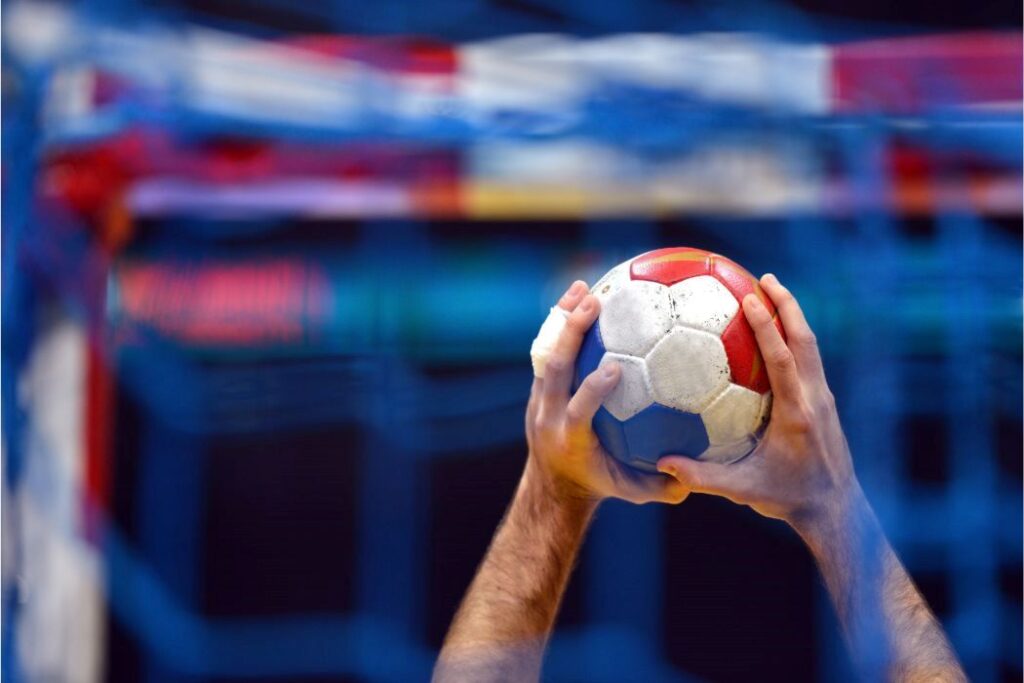At first glance, handball and soccer balls may appear quite similar. However, when you examine them closely, there are several key differences between these two types of balls. Here are some of the main ways handball and soccer balls vary:
- Size – Handball balls are smaller than soccer balls.
- Weight – Handball balls are heavier and more dense.
- Materials – Handballs use leather or synthetic leather while soccer balls use synthetic panels.
- Bounce – Handballs have a more controlled bounce compared to soccer balls.
- Grip – Handballs have a grainy surface for enhanced handling.
- Pressure – Handballs require higher inflation pressure.
In this article, we’ll explore all facets including size, weight, construction, bounce qualities, speed metrics, and regulations. You’ll also find a handy comparison chart. Let’s jump in!

Difference in Size
One obvious difference is that handball balls are smaller than soccer balls.
The standard size for a handball is 50-54cm circumference (about 20 inches around) which gives it a diameter of 7 inches.
Soccer balls have a larger circumference of 68-70cm (27 inches) with a diameter around 8.5 inches. The more compact size allows for easier handling and passing in handball.
Difference in Weight
In addition to a smaller size, handball balls are heavier than soccer balls. A regulation handball weighs 425-475 grams (15-17 ounces).
Comparatively, a regulation soccer ball weighs between 420-445 grams (14-16 ounces). While only a few ounces difference, the handball feels more solid and substantial during play. The additional weight gives it authority for powerful shots and throws.
Materials Used
Handballs traditionally feature leather exteriors which provide great grip and a soft feel. Many modern handballs use synthetic leather instead as a cost effective alternative.
But inside the outer casing, they contain a latex or butyl rubber bladder for shape retention.
Soccer balls used to be leather as well historically, but today feature plastic or PU panels over the inner bladder to create a smooth, water resistant outer shell.
History of Both Balls
Forms of handball existed in ancient cultures from Asia to Egypt, Greece, and Rome. The modern handball emerged in northern European countries in the 19th century.
Soccer balls also originated from ancient kick ball games, with the first balls made from stitched leather panels. Charles Goodyear’s vulcanized rubber helped soccer balls bounce better in the mid-1800s.
Bounce Characteristics
Handballs have a controlled, low-medium bounce which allows for handling and accurate passing between players. Too much rebound would make ball control tougher.
Soccer balls exhibit a high, lively bounce crucial for dribbling, headers, crosses, and shots. The ball needs to spring off various playing surfaces and retain momentum.
Speed They Travel
Handballs can reach speeds around 50-80 mph from powerful throws and spikes. However, slower manipulation is required for strategic team play.
Soccer balls kicks can exceed 100+ mph from free kicks and clears by elite professionals. But recreational players kick around 20-40 mph.
How Fast is a Serve?
In handball, the serve can reach speeds over 45 mph, struck high from the server’s side towards the opponent’s goal. Power and placement are key!
Soccer doesn’t have explicit serves – but goal kicks restart play and can travel 50+ mph. Outfield roll-ins also quickly restart play.
World Record Speeds
There are no official records for top handball throwing speed, but around 80 mph is considered extremely high velocity.
The record for fastest soccer kick is 131 mph by Brazilian striker Ronny Heberson Firmino in 2019.
Comparison to Other Balls
The handball is similar to other small dense balls like a lacrosse ball. But it bounces more than a lacrosse ball and is not as heavy as a shot put.
Soccer balls share qualities like size and weight with rugby balls, footballs, and volleyballs. But a soccer ball bounces medium-high versus a football’s lower bounce.
Best Brands
Top handball brands are Select, Molten, and Mikasa – known for quality leather materials and optimal grip. Budget models by Tachikara and Champion Sports perform well for recreational play.
For soccer balls, leading manufacturers include Adidas, Nike, Mitre, PUMA. Premium match balls run $150+ but casual players can find quality under $50 from brands like Select and Wilson.
Maintenance
Handballs require wiping down to remove body oils and dirt that degrade the leather over time. Use only mild cleanser and air dry fully after use.
Soccer balls also need gentle cleaning along with proper inflation around 8-12 PSI. Check and refill pressure weekly.
Old Ball vs New Ball
Old handballs lose their grainy grip and shape from repeated handling and play. A new ball provides ideal grip and rebound.
Soccer balls decline with age – losing pressure, absorbing moisture, and becoming misshapen from repeated impacts. Nothing beats a brand new ball for optimal carry and bounce.
In summary, handball and soccer balls differ in size, weight, materials, bounce, speed, and regulations – but both deliver fun recreational play and intense competitive action! Understanding their unique properties helps select the right ball for your needs.
